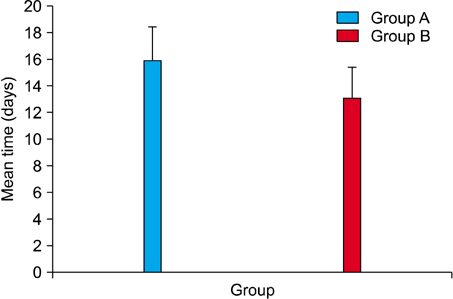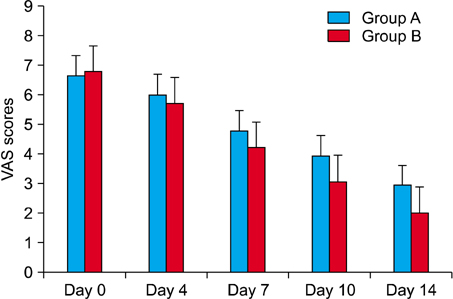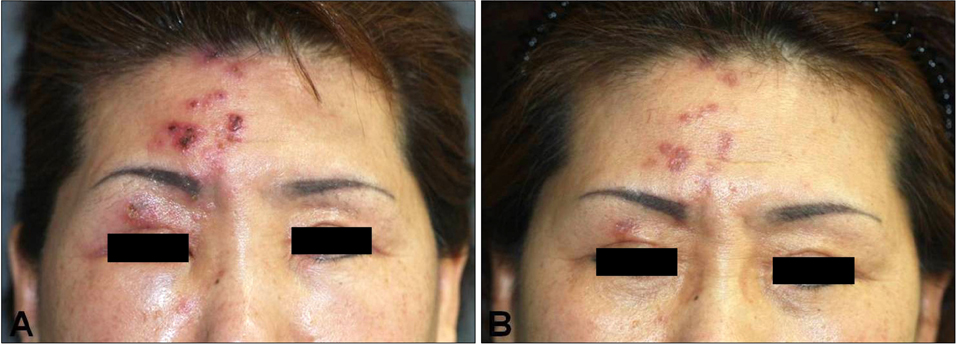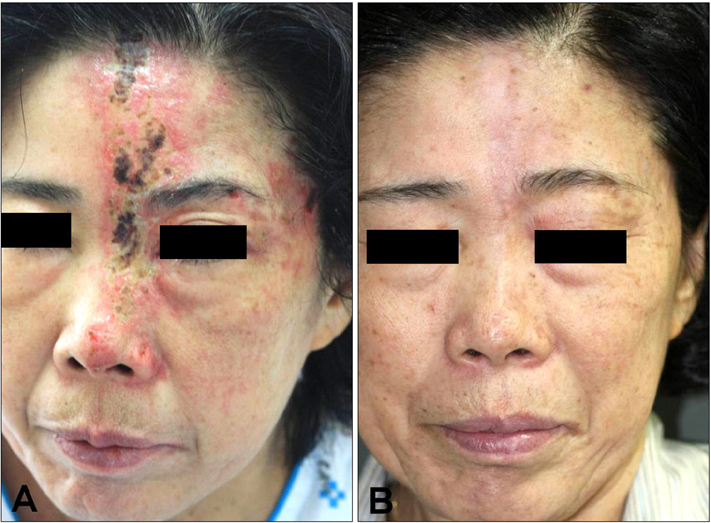Ann Dermatol.
2013 May;25(2):163-167. 10.5021/ad.2013.25.2.163.
The Effects of 830 nm Light-Emitting Diode Therapy on Acute Herpes Zoster Ophthalmicus: A Pilot Study
- Affiliations
-
- 1Department of Dermatology, Chung-Ang University College of Medicine, Seoul, Korea. beomjoon@unitel.co.kr
- 2Department of Dermatology, Eulji General Hospital, Seoul, Korea.
- KMID: 2171783
- DOI: http://doi.org/10.5021/ad.2013.25.2.163
Abstract
- BACKGROUND
Skin lesions and pain are the most distinctive features of herpes zoster. Light-emitting diode (LED) therapy is an effective treatment known for its wound-healing effects.
OBJECTIVE
To determine whether the LED treatment affects wound healing and acute pain in acute herpes zoster ophthalmicus.
METHODS
We recruited 28 consecutive Korean patients with acute herpes zoster ophthalmicus for the study. In the control group (group A), 14 subjects received oral famcyclovir. In the experimental group (group B), 14 subjects received oral famcyclovir and 830 nm LED phototherapy on days 0, 4, 7, and 10. In order to estimate the time for wound healing, we measured the duration from the vesicle formation to when the lesion crust fell off. The visual analogue scale (VAS) was used for the estimation of pain on days 4, 7, 10, and 14.
RESULTS
The mean time required for wound healing was 13.14+/-2.34 days in group B and 15.92+/-2.55 days in group A (p=0.006). From day 4, the mean VAS score showed a greater improvement in group B, compared with group A. A marginal but not statistically significant difference in the VAS scores was observed between the two groups (p=0.095).
CONCLUSION
LED treatment for acute herpes zoster ophthalmicus leads to faster wound healing and a lower pain score.
MeSH Terms
Figure
Reference
-
1. Whelan HT, Smits RL Jr, Buchman EV, Whelan NT, Turner SG, Margolis DA, et al. Effect of NASA light-emitting diode irradiation on wound healing. J Clin Laser Med Surg. 2001. 19:305–314.
Article2. Vinck EM, Cagnie BJ, Cornelissen MJ, Declercq HA, Cambier DC. Increased fibroblast proliferation induced by light emitting diode and low power laser irradiation. Lasers Med Sci. 2003. 18:95–99.
Article3. Minatel DG, Frade MA, França SC, Enwemeka CS. Phototherapy promotes healing of chronic diabetic leg ulcers that failed to respond to other therapies. Lasers Surg Med. 2009. 41:433–441.
Article4. Caetano KS, Frade MA, Minatel DG, Santana LA, Enwemeka CS. Phototherapy improves healing of chronic venous ulcers. Photomed Laser Surg. 2009. 27:111–118.
Article5. Moncada S, Erusalimsky JD. Does nitric oxide modulate mitochondrial energy generation and apoptosis? Nat Rev Mol Cell Biol. 2002. 3:214–220.
Article6. Barolet D. Light-emitting diodes (LEDs) in dermatology. Semin Cutan Med Surg. 2008. 27:227–238.
Article7. Russell BA, Kellett N, Reilly LR. A study to determine the efficacy of combination LED light therapy (633 nm and 830 nm) in facial skin rejuvenation. J Cosmet Laser Ther. 2005. 7:196–200.
Article8. Enwemeka CS, Parker JC, Dowdy DS, Harkness EE, Sanford LE, Woodruff LD. The efficacy of low-power lasers in tissue repair and pain control: a meta-analysis study. Photomed Laser Surg. 2004. 22:323–329.
Article9. Bjordal JM, Johnson MI, Iversen V, Aimbire F, Lopes-Martins RA. Low-level laser therapy in acute pain: a systematic review of possible mechanisms of action and clinical effects in randomized placebo-controlled trials. Photomed Laser Surg. 2006. 24:158–168.
Article
- Full Text Links
- Actions
-
Cited
- CITED
-
- Close
- Share
- Similar articles
-
- Corrigendum: The Effects of 830 nm Light-Emitting Diode Therapy on Acute Herpes Zoster Ophthalmicus: A Pilot Study
- Ophthalmoplegia in Herpes Zoster Ophthalmicus
- Ophthalmoplegia in Herpes Zoster Ophthalmicus
- A Case of Isolated Iridoplegia in Herpes Zoster Ophthalmicus
- Herpes Zoster Treated with Vidarabine-5-Monophosphate





